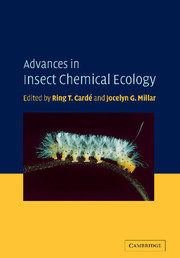Book contents
- Frontmatter
- Contents
- List of contributors
- Preface
- 1 Phytochemical diversity of insect defenses in tropical and temperate plant families
- 2 Recruitment of predators and parasitoids by herbivore-injured plants
- 3 Chemical ecology of astigmatid mites
- 4 Semiochemistry of spiders
- 5 Why do flowers smell? The chemical ecology of fragrance-driven pollination
- 6 Sex pheromones of cockroaches
- 7 A quest for alkaloids: the curious relationship between tiger moths and plants containing pyrrolizidine alkaloids
- 8 Structure of the pheromone communication channel in moths
- Index
- References
7 - A quest for alkaloids: the curious relationship between tiger moths and plants containing pyrrolizidine alkaloids
Published online by Cambridge University Press: 07 August 2009
- Frontmatter
- Contents
- List of contributors
- Preface
- 1 Phytochemical diversity of insect defenses in tropical and temperate plant families
- 2 Recruitment of predators and parasitoids by herbivore-injured plants
- 3 Chemical ecology of astigmatid mites
- 4 Semiochemistry of spiders
- 5 Why do flowers smell? The chemical ecology of fragrance-driven pollination
- 6 Sex pheromones of cockroaches
- 7 A quest for alkaloids: the curious relationship between tiger moths and plants containing pyrrolizidine alkaloids
- 8 Structure of the pheromone communication channel in moths
- Index
- References
Summary
Introduction
A curious relationship exists between a group of plants, the pyrrolizidine alkaloids they contain, and tiger moths of the family Arctiidae. Tiger moths possess an impressive array of chemicals, either produced de novo or sequestered from plants, that protect them to a greater or lesser degree from predators and parasites. These chemicals include cyossin (Teas et al., 1966), biogenic amines (Bisset et al., 1959, 1960; Rothschild and Aplin, 1971), pyrazines (Rothschild et al., 1984), polyphenolics (Hesbacher et al., 1995), iridoid glycosides (Bowers and Stamp, 1997), and cardenolides (Rothschild et al., 1970, 1973; Wink and von Nickisch-Rosenegk, 1997); however, no group of compounds, it seems, has influenced the natural history and behavior of tiger moths as the pyrrolizidine alkaloids (PAs) have done (Weller et al., 2000a). Several excellent reviews have been written about these compounds from the perspective of their chemistry, the plants that produce them (Bull et al.; 1968; Mattocks, 1986; Hartmann and Witte, 1995), and the insects that utilize them (Schneider, 1986; Boppré, 1990; Hartmann and Ober, 2000), but none has focussed exclusively, on their intimate relationships with tiger moths.
The members of the family Arctiidae, which numbers over 11 000 species, are often brilliantly colored (Watson and Goodger, 1986; Holloway, 1988; Weller et al., 2000a). In addition to standard aposematic red, yellow, or black patterns, adults and larvae may have iridescent blue and green, or even pearly white, coloration. White can be considered aposematic when individuals rest conspicuously on green vegetation.
- Type
- Chapter
- Information
- Advances in Insect Chemical Ecology , pp. 248 - 282Publisher: Cambridge University PressPrint publication year: 2004
References
- 21
- Cited by



